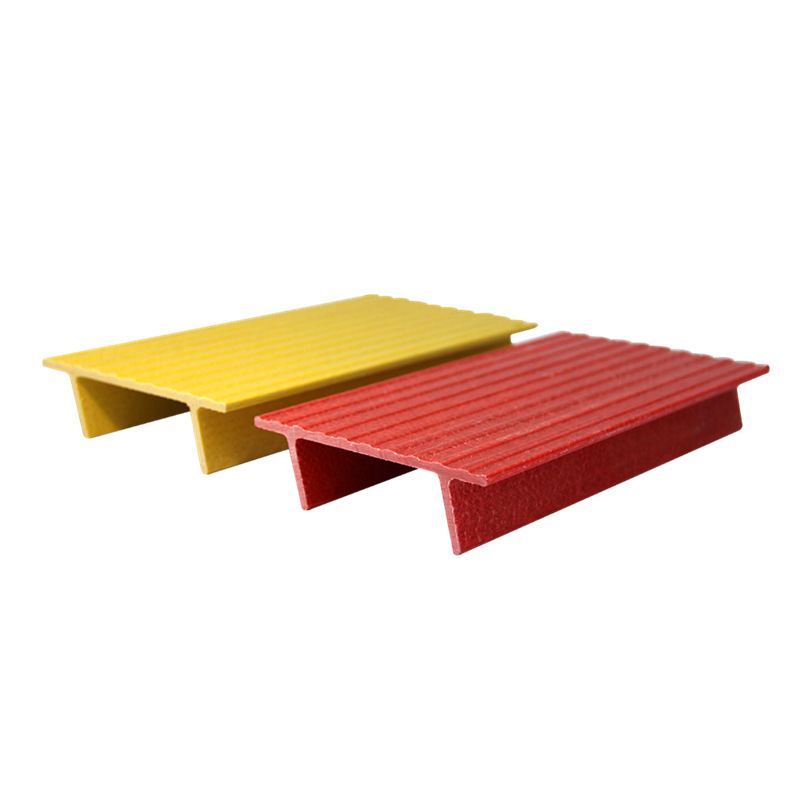Overview
The glass fibers, accounting for 60-70% by volume, are strategically oriented to provide longitudinal strength, while the resin matrix ensures dimensional stability and resistance to environmental factors. These profiles come in various cross-sectional shapes, including I-beams, channels, angles, and custom designs, with standard lengths ranging from 3 to 12 meters and customizable surface finishes such as smooth, textured, or gel-coat.
The manufacturing process involves pulling pre-impregnated glass fiber rovings and mats through a heated die, where the resin cures to form rigid, uniform structures. This results in profiles with exceptional strength-to-weight ratios, typically 2-3 times stronger than aluminum and 5 times lighter than steel, while maintaining dimensional accuracy within ±0.1mm. The composite nature allows for tailoring mechanical properties, such as tensile strength (180-300 MPa) and flexural modulus (12-20 GPa), to meet specific application requirements.
Features
Extreme Corrosion Resistance: Unlike metallic profiles, fiberglass extrusions are inert to chemicals, salts, and moisture, making them ideal for harsh environments like coastal structures, chemical plants, and wastewater treatment facilities.
Thermal & Electrical Insulation: With a thermal conductivity of 0.2-0.4 W/m·K and dielectric strength over 15 kV/mm, these profiles prevent heat transfer and electrical conduction, suitable for applications requiring non-conductive or thermally stable components.
Low Maintenance: The gel-coat surface resists UV degradation, fading, and chemical staining, eliminating the need for painting or galvanization and reducing lifecycle costs by up to 70%.
Design Flexibility: Customizable cross-sections and material formulations allow engineers to optimize profiles for load-bearing capacity, impact resistance, or fire retardancy (meeting ASTM E84 Class 1 fire ratings when formulated with flame-retardant resins).
Sustainable Production: Using recycled glass fibers and low-VOC resins, the manufacturing process aligns with green building standards, and the profiles are 100% recyclable at end-of-life.
Applications
Construction: Structural framing for buildings, walkways, and mezzanines in corrosive environments; non-conductive ladders and scaffolding for electrical installations.
Transportation: Lightweight supports for railway carriages, truck bodies, and marine vessels, reducing fuel consumption while enhancing durability.
Industrial Equipment: Machine guards, conveyor components, and chemical tank supports in pulp & paper, mining, and petroleum industries.
Renewable Energy: Wind turbine access platforms, solar panel mounting structures, and geothermal well casings requiring resistance to extreme temperatures and harsh soils.
FAQ
Q: Can Fiberglass Extruded Profiles be cut or drilled on-site?
A: Yes, standard woodworking or metalworking tools can be used, though carbide-tipped blades are recommended to prolong tool life. Always wear protective gear to avoid fiber inhalation.
Q: What is the service temperature range?
A: Most profiles operate between -40°C and 120°C. For higher temperatures (up to 200°C), specialized resin systems like phenolic or epoxy can be specified.
Q: How do they compare to aluminum in load-bearing applications?
A: While aluminum has higher raw strength, fiberglass profiles offer superior strength-to-weight ratio and corrosion resistance. For equivalent load capacity, fiberglass components are typically 30% lighter.
Q: Can custom colors be provided?
A: Yes, gel-coat finishes are available in a wide range of colors, and UV-stabilized pigments ensure color retention for over 20 years in outdoor environments.






















